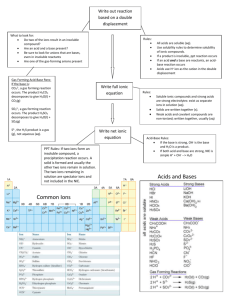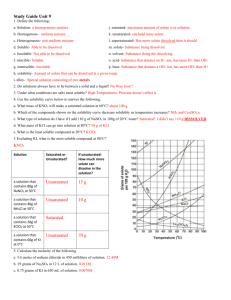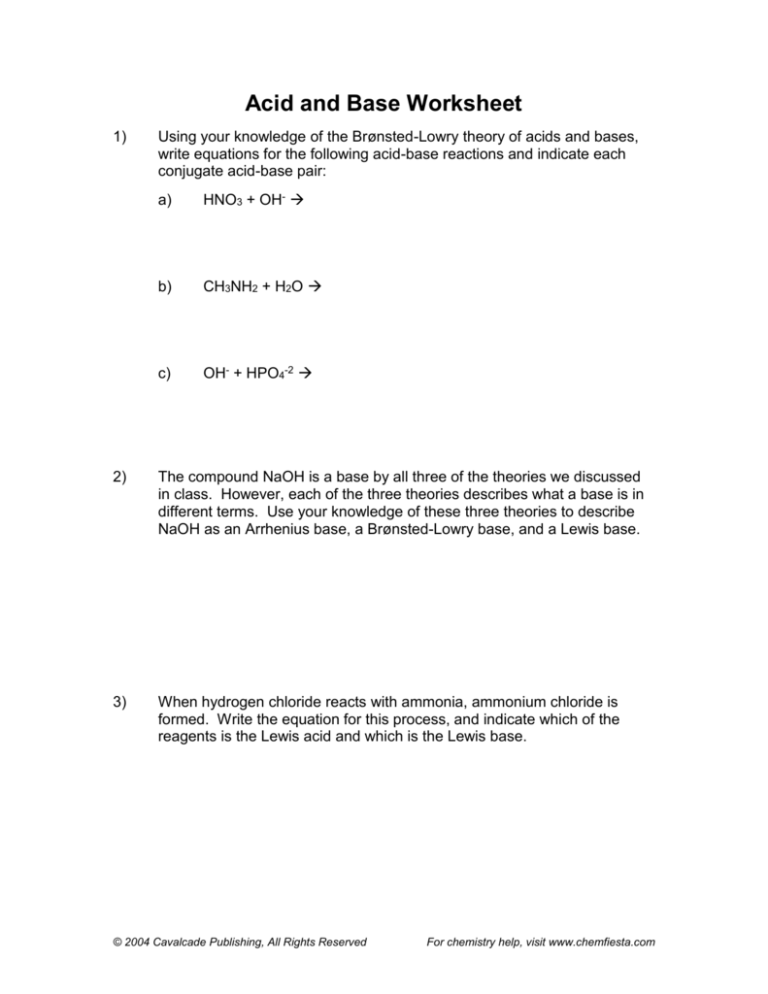
Acid and Base Worksheet
1)
Using your knowledge of the Brønsted-Lowry theory of acids and bases,
write equations for the following acid-base reactions and indicate each
conjugate acid-base pair:
a)
HNO3 + OH-
b)
CH3NH2 + H2O
c)
OH- + HPO4-2
2)
The compound NaOH is a base by all three of the theories we discussed
in class. However, each of the three theories describes what a base is in
different terms. Use your knowledge of these three theories to describe
NaOH as an Arrhenius base, a Brønsted-Lowry base, and a Lewis base.
3)
When hydrogen chloride reacts with ammonia, ammonium chloride is
formed. Write the equation for this process, and indicate which of the
reagents is the Lewis acid and which is the Lewis base.
© 2004 Cavalcade Publishing, All Rights Reserved
For chemistry help, visit www.chemfiesta.com
4)
Write an equation for the reaction of potassium metal with hydrochloric
acid.
5)
Borane (BH3) is a basic compound, but doesn’t conduct electricity when
you dissolve it in water. Explain this, based on the definitions of acids and
bases that we discussed in class.
6)
Write the names for the following acids and bases:
7)
a)
KOH ____________________________________
b)
H2Se ____________________________________
c)
C2H3O2H ____________________________________
d)
Fe(OH)2 ____________________________________
e)
HCN ____________________________________
Write the formulas for the following chemical compounds (remember,
you’ve still got a pop quiz coming up before the end of next week!)
a)
ammonium sulfate ____________________________________
b)
cobalt (III) nitride ____________________________________
c)
carbon disulfide ____________________________________
d)
aluminum carbonate ____________________________________
e)
chlorine ____________________________________
© 2004 Cavalcade Publishing, All Rights Reserved
For chemistry help, visit www.chemfiesta.com
Acid and Base Worksheet - Answers
1)
Using your knowledge of the Brønsted-Lowry theory of acids and bases,
write equations for the following acid-base reactions and indicate each
conjugate acid-base pair:
a)
HNO3 + OH- H2O + NO3HNO3 and NO3- make one pair
OH- and H2O make the other
b)
CH3NH2 + H2O CH3NH3+ + OHCH3NH2 and CH3NH3+ make one pair
OH- and H2O make the other
c)
OH- + HPO4-2 H2O + PO4-3
HPO4-2 and PO4-3 make one pair
OH- and H2O make the other
2)
The compound NaOH is a base by all three of the theories we discussed
in class. However, each of the three theories describes what a base is in
different terms. Use your knowledge of these three theories to describe
NaOH as an Arrhenius base, a Brønsted-Lowry base, and a Lewis base.
NaOH is an Arrhenius base because it creates OH- ions when
placed in water.
NaOH is a Brønsted-Lowry base because it accepts H+ ions from
acids.
NaOH is a Lewis base because the lone pairs on the hydroxide
ion can be donated to other compounds.
3)
When hydrogen chloride reacts with ammonia, ammonium chloride is
formed. Write the equation for this process, and indicate which of the
reagents is the Lewis acid and which is the Lewis base.
HCl + NH3 NH4Cl
NH3 is a Lewis base because it uses its lone pair electrons to pull a
hydrogen atom from hydrochloric acid.
HCl is a Lewis acid because it accepts electrons from NH3 when the
H is transferred.
© 2004 Cavalcade Publishing, All Rights Reserved
For chemistry help, visit www.chemfiesta.com
4)
Write an equation for the reaction of potassium metal with hydrochloric
acid.
2 K + 2 HCl 2 KCl + H2
5)
Borane (BH3) is a basic compound, but doesn’t conduct electricity when
you dissolve it in water. Explain this, based on the definitions of acids and
bases that we discussed in class.
Borane is a Lewis base, but a negligibly strong Brønsted-Lowry
base.
6)
Write the names for the following acids and bases:
7)
a)
KOH
potassium hydroxide
b)
H2Se
hydroselenic acid
c)
C2H3O2H
acetic acid
d)
Fe(OH)2
iron(II) hydroxide
e)
HCN
hydrogen cyanide or hydrocyanic acid
Write the formulas for the following chemical compounds (remember,
you’ve still got a pop quiz coming up before the end of next week!)
a)
ammonium sulfate
(NH4)2SO4
b)
cobalt (III) nitride
CoN
c)
carbon disulfide
CS2
d)
aluminum carbonate
Al2(CO3)3
e)
chlorine
Cl2
Home
© 2004 Cavalcade Publishing, All Rights Reserved
For chemistry help, visit www.chemfiesta.com

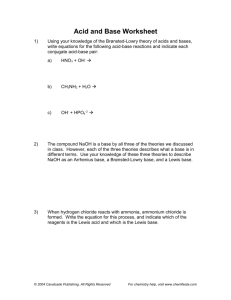



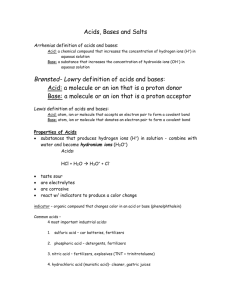


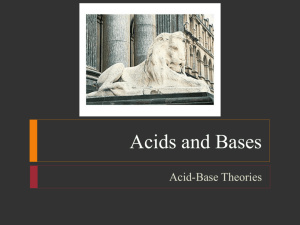

![pH = - log [H + ]](http://s2.studylib.net/store/data/005622524_1-002df1ea50d2a849b15deb604928664e-300x300.png)
